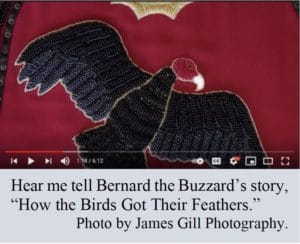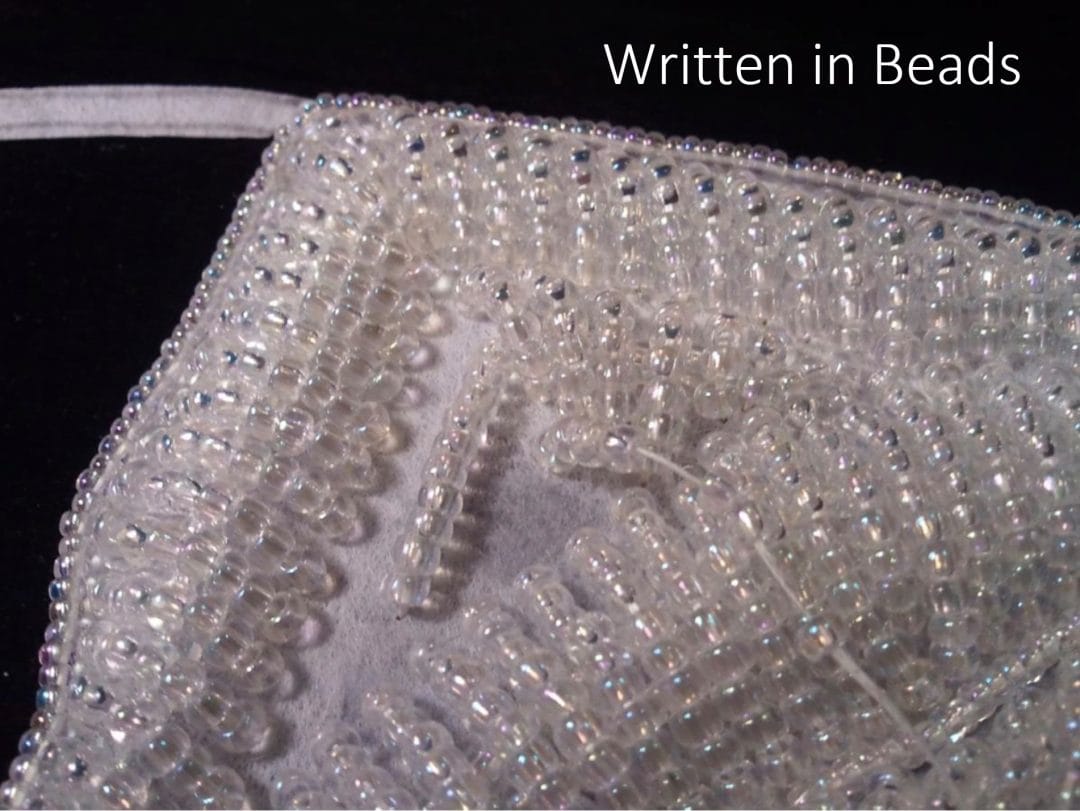
Detail shot showing structure and overcast of beadwork, Rock Art Caribou. Photo by Karen Ann Hoffman.
Shekoli (Greetings), my name is Karen Ann Hoffman. I’m a Haudenosaunee Raised Beadwork artist and a citizen of the Oneida Nation of Wisconsin, one of the Six Nations of the Haudenosaunee. From colonial days, the French called us the League of the Iroquois, but Haudenosaunee, which translates roughly to People of the Longhouse, is the name we call ourselves. Our original homeland is in the Eastern Great Lakes stretching roughly from Lake Erie eastward to the Hudson River both north and south of that imaginary dividing line between what are now called the United States and Canada.
From our earliest days, in addition to song and story, we have used forms and designs to transmit our worldview, to carry our culture forward. Early on our traditions were etched into shell and stone. Later we used land-based materials like clay, moose hair, and hide to hold our teachings. Now, with glass beads and thread, we continue a long chain of unbroken cultural transmission. While the materials have changed over time, the message has not.
Since the 1800s we have developed a specific style of Haudenosaunee Raised Beadwork that is a cultural hallmark for us. Our designs grow from our Eastern Woodland environment. Like many Woodland people, we use the flowers, berries, animals, and natural features endemic to our homeland as common design elements. What is unique to us is the way our beads are sewn onto fabric, typically velvet, velveteen, or wool, in a dimensional, mounded fashion so that the beadwork rises high above the substrate. To accomplish this three-dimensional effect, we use small glass seed beads sewn down with bees-waxed cotton thread and a steel needle. Atop a paper pattern, a row of beads is sewn down in one direction (the structure) and then overcast with multiple rows of beads sewn down in the opposite direction. I marvel that these simple elements, handled properly by a person of a Good Mind, provide everything necessary to craft another strong link in our cultural chain.
Some years back I was listening to Wisconsin Public Radio. An anthropologist, whose name I have since forgotten, said something to the effect of “civilization began with the advent of the written word.” Oh my, I thought, that’s just shortsighted. Writing may go back a long way, and it’s doubtless a good thing, but for millennia Native American cultures have been strong, vibrant, and “civilized” without the use of a codified written language. Songs, stories, and figural art are, I knew from experience, perfectly capable of transporting complex cultural cargo.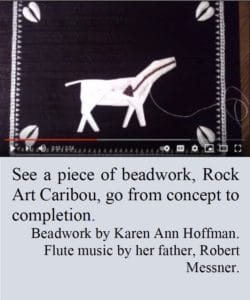
At that moment I was inspired to begin a series of beadwork pieces that would write our stories, our traditions, using our Raised Beadwork as the alphabet.
I began by thinking about the formation of the Haudenosaunee Confederacy. I’d heard the story many times of how five once-warring Nations gathered together under the Great White Pine, the Tree of Peace, with its four white roots. The women of those Nations had instructed their head men to sit together around a Council Mat. Council Mats may, in certain circumstances, be thought of as a point of gathering. Implicit in that gathering is the commitment by the participants to work to create solutions that are in the best interest of all, no matter how long that may take or how complex that task may be. Those solutions must respect the past, respond to the moment, and lay a bountiful table for those whose faces are yet to be seen. Agreement to these solutions must be by consensus so that all feel their concerns have been respectfully heard, and equitably included in the solution. Urged on by Jigonhsasee, the Mother of Nations, the men were told to sit and talk until they found a way to live together in Peace. A Council Fire burned adjacent to the men. The retelling said that the Council Mat was a white deerskin and that someone was assigned to fan the ash off the mat because, “…a clean mat means a clear mind and a clear mind makes good decisions.”
Over the next six years, I beaded four Council Mats and a red Flame Urn to act as symbols for the retelling of this fundamental story. I also added another layer; rather than leaving the Council Mats blank, I embellished them with beadwork. I beaded each mat with a different seasonal tradition. If a clean mat could spark a clear mind, I reasoned, how much more effective might a mat emblazoned with cultural symbols be?
I began beading the first of the Council Mats with a well-known Fall tradition that is written in the night sky for all to see: the Great Bear Hunt. Without using a word, the beadwork remembers four brothers and their little white dog with black rings around his eyes. The mat talks about how those brothers and their dog Four Eyes trailed the Great Bear into the Sky and killed him. How, because it is wrong to kill without feasting and gratitude, the brothers butchered Bear, causing Bear’s blood to drip down from the stars, coloring Maple’s leaves a bright red. The beads explain how after the butchering, the Brothers roasted Bear for a great feast, Bear’s fat sizzling down to Earth as snow. How after the feast the Brothers rested until awoken by the trail bark of Four Eyes. The little white dog with black circles around his eyes was once again on the trail of Bear, who had reconstituted himself and was traversing the night sky.
Learning the Story
Great Bear Hunt is a long and nuanced story. Its telling can go on for hours. And, as with many traditions, there is no clear ending, only a choice of highlighting one principle or another and emphasizing those elements in a particular telling. The teachings in one “story” morph seamlessly into others, weaving a continuous exploration of culture. The Great Bear Hunt is just one truly wonderful example of the interconnected nature of Haudenosaunee worldview.

Great Bear Hunt Mat. Photo by James Gill Photography.
Pleased with the outcome, I went on to bead a Spring Council Mat depicting the joyous return of the birds, in this case, Sandhill Cranes. It is said that the return of the birds in the Spring is a reminder to be hopeful.

Spring Crane Mat. Photo by Karen Ann Hoffman
Following these two seasons, I used raised beadwork to write the Summer story of the Three Sisters Garden. This mat celebrates the Haudenosaunee teachings of growing Corn, Squash, and Beans together in an earthen mound. We know this cooperative community approach to gardening to be healthful for the plants, the soil, and our bodies. The beaded presence of our Elder Brother the Sun in the upper right of the mat is mirrored by the warmth of His shape as a negative space in the base of the mound. The dangles along the bottom of the mat remind us of the importance of Water and Rain to the success of our gardens and, consequently, to the lives and the health of our People. Written with beadwork, this figural mat explains a host of cooperative ecological teachings given to us Haudenosaunee in our Original Instructions.
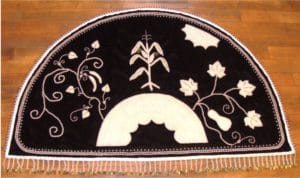
Summer story of the Three Sisters Garden. Photo by Karen Ann Hoffman.
The Mat Series culminated with the beading of Winter Story, a circular mat created from custom-dyed, icy-blue silk velvet. Turtle swims in the center of the mat as a symbol of our land—Turtle Island. It is said there was a time when Creator needed to turn His attention away for a short while. Creator gave Trees the responsibility to keep watch over everything on Turtle Island during this time. Trees proudly agreed and were awake and watchful for a long time. But the time became longer and longer. Trees grew tired and one by one fell asleep, abandoning their responsibilities. First the Poplars, then the Maples and Elms, and finally even the Oaks slumbered in Creator’s absence. Upon return, Creator found that only the Pines had lived up to their responsibilities and stayed awake and alert the whole time. As a reward for Pine’s commitment, Pines keep their green all the year through while the other trees lose their leaves in the order in which they failed their commitments to their brothers and sisters on Turtle Island. This teaching of commitment to community over self is a key element in the worldview of our People.
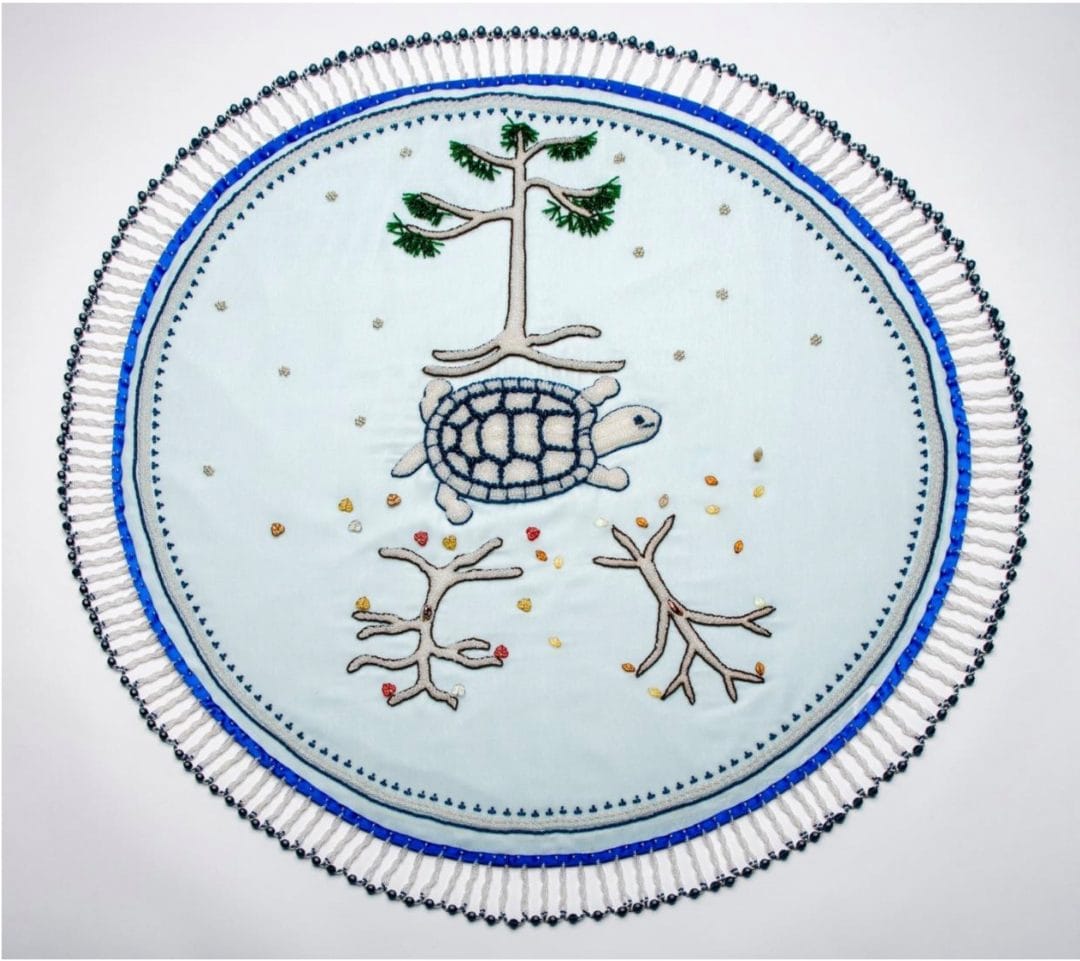
Winter Story Mat. Photo by James Gill Photography.
As I continued to write with beads, I understood that my beadwork has less to do with me than it does with my responsibilities. My responsibility to understand the gifts and limitations of the materials with which I work so that they can excel at what they do. My responsibility to understand deeply the teaching and traditions that I am given to work with so that the voice of the beadwork is strong and clear. I am responsible for getting it right. A slow and thoughtful beader, I’ll often spend a year or more on each of my “legacy pieces.” There will be months of researching, talking with Elders, experimenting with pattern making, and testing an idea prior to taking the first of thousands of hand stitches. This level of intimacy with the artworks imbues them with a life and an animacy beyond my own. As Native people we exist in the worlds of our ancestors, the present, and the unseen faces, all at the same time. As an artist, it is my intention that my work have this same relationship to our community.

Bernard the Buzzard Bag. Photo by James Gill Photography.
A recent foray into beaded storytelling is my Bernard the Buzzard Bag. Bernard is born of six different shades of black beads, transparent ruby red beads, and a vintage glass taxidermy eye. He soars toward our Elder Brother beaded with 14-karat gold beads on a field of maroon velvet.
The concept for the Bernard the Buzzard Bag began with an everyday run into town for groceries with my husband, Mike. Some days earlier we had noticed a dead rabbit along the side of our county road. We had enjoyed watching the local buzzards feasting on the carrion during our rides to town, although they always flew off as we approached.
On this day, one of the buzzards stayed on the ground. “Odd,” we thought. “Car hit,” we figured. Mike pulled over and gently moved the barely breathing bird off the gravel shoulder and into the cooler, quiet grasses in the ditch to die quietly. “Poor thing,” we thought. “Reminds me of my Uncle Bernard,” I said.
On our return trip, we glanced into the ditch to look at the dead buzzard. But Bernard wasn’t dead, he weakly flapped a wing as we passed by, and Mike hit the brakes. “Bernard needs us,” he said.
We wrapped Bernard in a blanket, put him in a box, and called REGI, the raptor recovery center a hundred miles away in northern Wisconsin. “Sure,” they said. “Bring him in, we’ll see what we can do.” Bernard didn’t survive the weekend. “Internal injuries,” the REGI people said.
Mike and I would talk about Bernard every time we went to town for groceries for a long time. Five seasons later, we were walking around our 40-acre property. It was a classic September day, bright skies, crisp breezes, the smell of Fall in the air. We looked up into that amazing September sky and saw a lone buzzard soaring great circles between the Sun and the Moon. “Wow!” we said. “Bernard!” we said.
At that moment, I saw the Buzzard Bag, complete and whole in my mind. “Bernard wants me to bead him,” I said. Mike agreed. And so, that afternoon, I sat down at my kitchen table and began Bernard the Buzzard Bag and the story he holds about how the birds got their feathers. Thanks, Bernard.
My Father, a truly fine musician, once asked me if I knew why musical notation, in all its varieties, was invented. Because, he said, human memory is limited. Dabs of ink on paper, Daddy said, allow us to share, and share precisely, more than memory can carry alone. Looking at a symphonic score he could literally hear the music that Ludwig had heard in his head an ocean away and two hundred years earlier. I think beads are like that too. I have come to understand that, if well crafted, those quiet little pieces of glass can out-last, out-share, and out-travel the original creator, carrying their voices to places the beader might never reach.
I am currently working on a multi-year project in concert with a local archeologist, Ray Reser. The university from which I graduated, the University of Wisconsin–Stevens Point, is built on a mass Native burial. This burial has been ignored since the campus opened in 1894. Wrenchingly, every day for nearly 130 years students, faculty, staff, and visitors have walked over the bodies of these Ancestors. It is my mission to bring rest and acknowledgment to them by insisting that the university install a Native-designed Monument/Marker on site. On a personal level, a piece of beadwork is growing out of this as well, a piece that will sing for and honor the lessons of those who can no longer speak with their mouths. Sometimes, I swear, I hear the voices of my Ancestors whispering in my ear and urging me on. “Do it right,” they say. “Do it well, Karen Ann. Share our lessons with a world that needs to learn.”
Peace.
Karen Ann Hoffman has been beading peace, beauty, and meaning through her Haudenosaunee Raised Beadwork since the 1990s. Haudenosaunee Raised Beadwork (also known as Iroquois Raised Beadwork) is unique to the Six Nations of the Haudenosaunee Confederacy, characterized by lines of beads that arch above the textile surface for a three-dimensional effect, typically sewn onto velvet. Hoffman is a respected national leader in this art, known for reimagining existing forms to expand their significance for today and the future. She is also an NEA National Heritage Fellow. Retired from a sales career, Hoffman pursues her twin goals of strengthening Haudenosaunee Raised Beadwork within the Haudenosaunee community and gaining recognition for it more widely. She produces two to three large pieces each year, with some in the permanent collections of the Smithsonian National Museum of the American Indian, the Field Museum, the Iroquois Indian Museum, and the Oneida Nation Museum. She teaches and hosts a beading circle at her home. She is a co-organizer of the annual International Iroquois Beadwork Conference and has curated multiple exhibits of work by Native artists.
Artist biography courtesy of Anne Pryor. Read more at https://www.arts.gov/honors/heritage/karen-ann-hoffman-oneida-nation-wisconsin
Artist Website https://karenannhoffman.com

